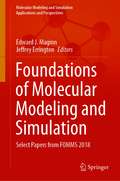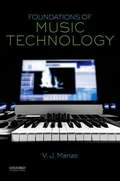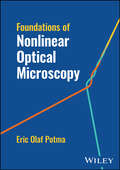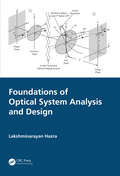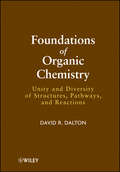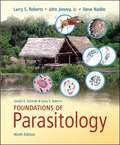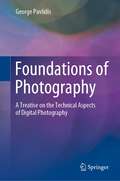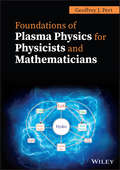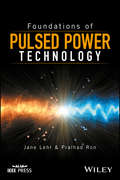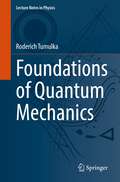- Table View
- List View
Foundations of Molecular Modeling and Simulation: Select Papers from FOMMS 2018 (Molecular Modeling and Simulation)
by Edward J. Maginn Jeffrey ErringtonThis highly informative and carefully presented book comprises select proceedings of Foundation for Molecular Modelling and Simulation (FOMMS 2018). The contents are written by invited speakers centered on the theme Innovation for Complex Systems. It showcases new developments and applications of computational quantum chemistry, statistical mechanics, molecular simulation and theory, and continuum and engineering process simulation. This volume will serve as a useful reference to researchers, academicians and practitioners alike.
Foundations of Music Technology
by V. J. ManzoMany people believe that technology alone can transform them into creative musicians. This myth is spread through advertisements for the latest gadgets, software, and gear. The strange reality is that we probably have more music technology, music software, and music controllers and instruments than we need, and certainly more than we realistically know what to do with. Honestly, technology makes it really easy for anyone to create uninteresting music. However, music technology can offer accessibility with regard to music-making activities that traditional acoustic instruments and methods cannot. Coupled with an education in traditional aspects of music theory, counterpoint, and ear-training, an understanding of the functions and inner workings of various technologies can help facilitate a multitude of creative musical objectives. In this book, the author will discuss technology and its uses as a mechanism to facilitate musicianship as well as a muse to spark creativity.
Foundations of Nonlinear Optical Microscopy
by Eric Olaf PotmaFoundations of Nonlinear Optical Microscopy Concise yet comprehensive resource presenting the foundations of nonlinear optical microscopy Foundations of Nonlinear Optical Microscopy brings together all relevant principles of nonlinear optical (NLO) microscopy, presenting NLO microscopy within a consistent framework to allow for the origin of the signals and the interrelation between different NLO techniques to be understood. The text provides rigorous yet practical derivations, which amount to expressions that can be directly related to measured values of resolution, sensitivity, and imaging contrast. The book also addresses typical questions students ask, and answers them with clear explanations and examples. Readers of this book will develop a solid physical understanding of NLO microscopy, appreciate the advantages and limitations of each technique, and recognize the exciting possibilities that lie ahead. Foundations of Nonlinear Optical Microscopy covers sample topics such as: Light propagation, focusing of light, pulses of light, classical description of light-matter interactions, and quantum mechanical description of light-matter interactionsMolecular transitions, selection rules, signal radiation, and detection of lightMulti-photon fluorescence and pump-probe microscopyHarmonic generation, sum-frequency generation, and coherent Raman scattering Senior undergraduate and graduate students in chemistry, physics, and biomedical engineering, along with students of electrical engineering and instructors in both of these fields, can use the information within Foundations of Nonlinear Optical Microscopy and the included learning resources to gain a concise yet comprehensive overview of the subject.
Foundations of Nuclear and Particle Physics
by T. W. Donnelly J. A. Formaggio B. R. Holstein R. G. Milner B. SurrowThis textbook brings together nuclear and particle physics, presenting a balanced overview of both fields as well as the interplay between the two. The theoretical as well as the experimental foundations are covered, providing students with a deep understanding of the subject. In-chapter exercises ranging from basic experimental to sophisticated theoretical questions provide an important tool for students to solidify their knowledge. Suitable for upper undergraduate courses in nuclear and particle physics as well as more advanced courses, the book includes road maps guiding instructors on tailoring the content to their course. Online resources including color figures, tables, and a solutions manual complete the teaching package. This textbook will be essential for students preparing for further study or a career in the field who require a solid grasp of both nuclear and particle physics.
Foundations of Optical System Analysis and Design
by Lakshminarayan HazraSince the incorporation of scientific approach in tackling problems of optical instrumentation, analysis and design of optical systems constitute a core area of optical engineering. A large number of software with varying level of scope and applicability is currently available to facilitate the task. However, possession of an optical design software, per se, is no guarantee for arriving at correct or optimal solutions. The validity and/or optimality of the solutions depend to a large extent on proper formulation of the problem, which calls for correct application of principles and theories of optical engineering. On a different note, development of proper experimental setups for investigations in the burgeoning field of optics and photonics calls for a good understanding of these principles and theories. With this backdrop in view, this book presents a holistic treatment of topics like paraxial analysis, aberration theory, Hamiltonian optics, ray-optical and wave-optical theories of image formation, Fourier optics, structural design, lens design optimization, global optimization etc. Proper stress is given on exposition of the foundations. The proposed book is designed to provide adequate material for ‘self-learning’ the subject. For practitioners in related fields, this book is a handy reference. Foundations of Optical System Analysis and Synthesis provides A holistic approach to lens system analysis and design with stress on foundations Basic knowledge of ray and wave optics for tackling problems of instrumental optics Proper explanation of approximations made at different stages Sufficient illustrations for facilitation of understanding Techniques for reducing the role of heuristics and empiricism in optical/lens design A sourcebook on chronological development of related topics across the globe This book is composed as a reference book for graduate students, researchers, faculty, scientists and technologists in R & D centres and industry, in pursuance of their understanding of related topics and concepts during problem solving in the broad areas of optical, electro-optical and photonic system analysis and design.
Foundations of Organic Chemistry: Unity and Diversity of Structures, Pathways, and Reactions
by David R. DaltonThis book differs from other organic chemistry textbooks in that it is not focused purely on the needs of students studying premed, but rather for all students studying organic chemistry. It directs the reader to question present assumptions rather than to accept what is told, so the second chapter is largely devoted to spectroscopy (rather than finding it much later on as with most current organic chemistry textbooks). Additionally, after an introduction to spectroscopy, thermodynamics and kinetics, the presentation of structural information of compounds and organic families advances from hydrocarbons to alcohols to aldehydes and ketones and, finally, to carboxylic acids.
Foundations of Parasitology (Ninth Edition)
by Larry S. Roberts John Janovy Steve NadlerA parasitology text for biology and/or zoology students at the undergraduate level. Emphasizes principles with related information on the biology, physiology, morphology, and ecology of the major parasites of humans and domestic animals. This is not a diagnostic manual for medical students.
Foundations of Perturbative QCD
by John CollinsThe most non-trivial of the established microscopic theories of physics is QCD: the theory of the strong interaction. A critical link between theory and experiment is provided by the methods of perturbative QCD, notably the well-known factorization theorems. Giving an accurate account of the concepts, theorems and their justification, this book is a systematic treatment of perturbative QCD. As well as giving a mathematical treatment, the book relates the concepts to experimental data, giving strong motivations for the methods. It also examines in detail transverse-momentum-dependent parton densities, an increasingly important subject not normally treated in other books. Ideal for graduate students starting their work in high-energy physics, it will also interest experienced researchers wanting a clear account of the subject.
Foundations of Photography: A Treatise on the Technical Aspects of Digital Photography
by George PavlidisThis book offers an in-depth technical presentation of photography and details about the inner workings of the digital camera, while keeping the artistic principles in mind. Departing from the current stream, the book treats photography as a highly scientific and technical subject, and serves as a reference to those who seek for an understanding of the technical aspects relating to the photographic camera, the beating heart of photography. It offers insight on why the photographs are created the way they are, highlighting also the limitations. As the author of this book is an image technology scientist and a photography enthusiast who has been teaching photography for a long time, this treatise reflects his own constant search and study for an in-depth understanding.
Foundations of Physical Science with Earth and Space Science
by Tom HsuLearn more about the physical world through hands-on activities and experiments.
Foundations of Physical Science with Earth and Space Science -- Investigations
by Tom HsuA science lab book that investigates various scientific topics in a systematic way and arranges every investigation with a key question, data tables, learning objectives, brief introduction, icons and section title, numbered steps, illustrations and fill-in answer sheets.
Foundations of Physics
by Robert L. Lehrman Clifford SwartzTextbook detailing the basics of physics
Foundations of Plasma Physics for Physicists and Mathematicians
by G. J. PertA comprehensive textbook on the foundational principles of plasmas, including material on advanced topics and related disciplines such as optics, fluid dynamics, and astrophysics Foundations of Plasma Physics for Physicists and Mathematicians covers the basic physics underlying plasmas and describes the methodology and techniques used in both plasma research and other disciplines such as optics and fluid mechanics. Designed to help readers develop physical understanding and mathematical competence in the subject, this rigorous textbook discusses the underlying theoretical foundations of plasma physics as well as a range of specific problems, focused on those principally associated with fusion. Reflective of the development of plasma physics, the text first introduces readers to the collective and collisional behaviors of plasma, the single particle model, wave propagation, the kinetic effects of gases and plasma, and other foundational concepts and principles. Subsequent chapters cover topics including the hydrodynamic limit of plasma, ideal magneto-hydrodynamics, waves in MHD plasmas, magnetically confined plasma, and waves in magnetized hot and cold plasma. Written by an acknowledged expert with more than five decades’ active research experience in the field, this authoritative text: Identifies and emphasizes the similarities and differences between plasmas and fluids Describes the different types of interparticle forces that influence the collective behavior of plasma Demonstrates and stresses the importance of coherent and collective effects in plasma Contains an introduction to interactions between laser beams and plasma Includes supplementary sections on the basic models of low temperature plasma and the theory of complex variables and Laplace transforms Foundations of Plasma Physics for Physicists and Mathematicians is the ideal textbook for advanced undergraduate and graduate students in plasma physics, and a valuable compendium for physicists working in plasma physics and fluid mechanics.
Foundations of Psychological Profiling: Terrorism, Espionage, and Deception
by Richard BloomProfiling is a hot topic today. The post-9/11 "War on Terrorism" has engendered political, ethical, and scientific controversy over its use. The proliferation of recent films, television programs, and books is a sociocultural indicator of widespread interest. Designed for a diverse audience including law enforcement officers, intelligence and secur
Foundations of Pulsed Power Technology
by Pralhad Ron Jane LehrExamines the foundation of pulse power technology in detail to optimize the technology in modern engineering settings Pulsed power technologies could be an answer to many cutting-edge applications. The challenge is in how to develop this high-power/high-energy technology to fit current market demands of low-energy consuming applications. This book provides a comprehensive look at pulsed power technology and shows how it can be improved upon for the world of today and tomorrow. Foundations of Pulsed Power Technology focuses on the design and construction of the building blocks as well as their optimum assembly for synergetic high performance of the overall pulsed power system. Filled with numerous design examples throughout, the book offers chapter coverage on various subjects such as: Marx generators and Marx-like circuits; pulse transformers; pulse-forming lines; closing switches; opening switches; multi-gigawatt to multi-terawatt systems; energy storage in capacitor banks; electrical breakdown in gases; electrical breakdown in solids, liquids and vacuum; pulsed voltage and current measurements; electromagnetic interference and noise suppression; and EM topology for interference control. In addition, the book: Acts as a reference for practicing engineers as well as a teaching text Features relevant design equations derived from the fundamental concepts in a single reference Contains lucid presentations of the mechanisms of electrical breakdown in gaseous, liquid, solid and vacuum dielectrics Provides extensive illustrations and references Foundations of Pulsed Power Technology will be an invaluable companion for professionals working in the fields of relativistic electron beams, intense bursts of light and heavy ions, flash X-ray systems, pulsed high magnetic fields, ultra-wide band electromagnetics, nuclear electromagnetic pulse simulation, high density fusion plasma, and high energy- rate metal forming techniques.
Foundations of Quantum Gravity
by James LindesayExploring how the subtleties of quantum coherence can be consistently incorporated into Einstein's theory of gravitation, this book is ideal for researchers interested in the foundations of relativity and quantum physics. The book examines those properties of coherent gravitating systems that are most closely connected to experimental observations. Examples of consistent co-gravitating quantum systems whose overall effects upon the geometry are independent of the coherence state of each constituent are provided, and the properties of the trapping regions of non-singular black objects, black holes, and a dynamic de Sitter cosmology are discussed analytically, numerically, and diagrammatically. The extensive use of diagrams to summarise the results of the mathematics enables readers to bypass the need for a detailed understanding of the steps involved. Assuming some knowledge of quantum physics and relativity, the book provides textboxes featuring supplementary information for readers particularly interested in the philosophy and foundations of the physics.
Foundations of Quantum Mechanics (Lecture Notes in Physics #1003)
by Roderich TumulkaThis book introduces and critically appraises the main proposals for how to understand quantum mechanics, namely the Copenhagen interpretation, spontaneous collapse, Bohmian mechanics, many-worlds, and others. The author makes clear what are the crucial problems, such as the measurement problem, related to the foundations of quantum mechanics and explains the key arguments like the Einstein-Podolsky-Rosen argument and Bell’s proof of nonlocality. He discusses and clarifies numerous topics that have puzzled the founding fathers of quantum mechanics and present-day students alike, such as the possibility of hidden variables, the collapse of the wave function, time-of-arrival measurements, explanations of the symmetrization postulate for identical particles, or the nature of spin. Several chapters are devoted to extending the different approaches to relativistic space-time and quantum field theory. The book is self-contained and is intended for graduate students and researchers who want to step into the fundamental aspects of quantum physics. Given its clarity, it is accessible also to advanced undergraduates and contains many exercises and examples to master the subject.
